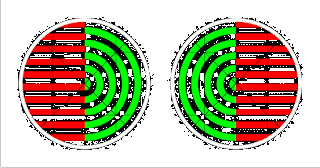Maybe not. A new paper suggests our different senses may be influencing each other more often than we think. The team looked at how smell, something we normally think of as one of our weaker, less important senses, hold sway over our vision, the sense that most people normally think of as our strongest, most important, senses.
Zhou and colleagues used a phenomenon called binocular rivalry to test this. Binocular rivalry is not when two binocular stores are competing on price.
Normally, the two halves of our brain get complementary information coming from each eye, which the brain stitches together into one almost seamless visual experience. Using a little bit of visual trickery, it’s possible to get all of the left brain being fed one image, and all of the right brain being fed a completely different, incompatible image. Face with two competing sets of information, people see only one image image at a time, alternating with the other, alternating with the other every few seconds, in an unpredictable way
You can get a sense of it from this picture. If you let your eyes cross so that the images are superimposed (a little like a 3-D stereogram).
In the overlapping image in the center, you will tend to see either green circles or red bars, not the half and half images. The two images will alternate back and forth in an unpredictable way.
 In their main experiment, Zhou and colleagues showed people rival pictures of a rose and a banana at the same time. While doing this, they gave their volunteers the smell of a rose, and people became more likely to see the image of the rose.
In their main experiment, Zhou and colleagues showed people rival pictures of a rose and a banana at the same time. While doing this, they gave their volunteers the smell of a rose, and people became more likely to see the image of the rose. When they gave them the smell of the banana, they were more likely to see the banana.
They also got this effect with a mix of images and words. In a second experiment (which must have been less fun for the volunteers), the rival images were a male torso and a set or words. When presented with the smell of, um, body odor. When presented with good ol’ B.O. (eeewww), the subjects were more likely to see the person instead of the words... but only if the smell of sweat was given in the right nostril.
Why does the nostril matter? Like the rest of our body, each nostril is wired to one half of the brain, so the input from each nostril has a different effect on one side of the brain than the other.
The “nostril” effect can be broken fairly easily, though. If you show a picture of a banana, with a rival image being the word “rose”, the scent of the rose still makes you more likely to see the word “rose,” but it no longer matters which nostril through which you smell the rose-like scent.
The one thing I can’t quite understand is why this paper is in The Journal of Neuroscience. There is no neuroscience in this paper. No brightly lit brain blobs, no EEGs, no neurons, nothing. This is a straight sensory perception paper.
Reference
Zhou W, Zhang X, Chen J, Wang L, Chen D. 2012. Nostril-specific olfactory modulation of visual perception in binocular rivalry. Journal of Neuroscience 32(48): 17225-17229. DOI: 10.1523/jneurosci.2649-12.2012
Binocular rivalry image from here. Nose by Caro's Lines on Flickr; rose and banana by cproppe on Flickr; both used under a Creative Commons license.



No comments:
Post a Comment